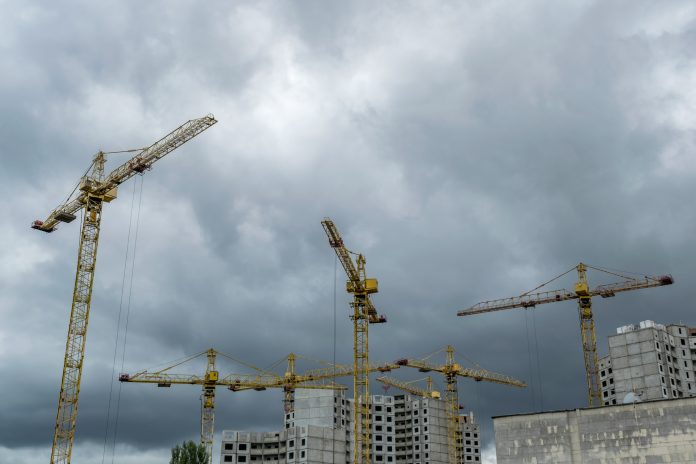Tom Adlington, building services and construction sector sales manager at Aggreko UK & Ireland, explores how humidity management is becoming more and more necessary in increasingly extreme weather conditions
As extreme weather becomes more common, managing humidity on construction site humidity is turning into a year-round concern for building professionals. However, without comprehensive planning and an adequate dehumidification system, sites are left open to moisture-related dangers and disruption from flooding, torrential showers and other weather events.
While records of weather extremities have been few and far between in past decades, they are becoming an increasingly regular phenomenon. Previous records are being broken by considerable margins, with the idea of ‘normal’ British weather changing at such a rate it can cloud judgement when preparing humidity management strategies.
Humidity is a year-round concern for construction sites
The humidity brought on by excessive rain and extreme weather has at best made working conditions uncomfortable and is at worst a major threat to equipment and project completion schedules.
However, while these events are often responsible for heightened on-site moisture levels, it is a key misconception that this is always the cause.
For instance, during the summer months warmer air expands, meaning while the relative humidity may show a lower percentage, the physical volume of moisture is still the same as under cooler conditions. So, while it may seem that hotter temperatures, such as those we experienced in summer 2022, will solve the issue of onsite moisture, this unfortunately isn’t the case.
Site and project managers impacted by disruption should therefore begin to consider practical methods to avoid long-term damage to plant construction equipment and materials.
Rather than a reactionary response to flooding events, effective humidity management requires a year-round approach which covers all possible scenarios. With this in mind, there has never been a greater need to ensure that proper humidity management techniques are employed to shelter from storms and other freak weather events that are becoming more common.
Humidity management should go beyond short term solutions
To alleviate the immediate challenges of moisture on construction sites, it can seem like common sense to subject affected areas to intense and rapid heating to effectively dry the moisture out.
However, the quickest drying solutions, such as flash drying, can exacerbate rather than solve the problem. Drying areas of the site without effectively removing moisture from the atmosphere can end in persistent damp as it only takes around 48 hours for moisture equilibrium to be restored and for the air to recirculate back into the building’s fabric.
Similarly, the use of direct heaters carries additional concerns surrounding excessive fuel usage, which the ongoing energy crisis has amplified.
To implement effective drying processes, we need to go deeper than the surface. While water from flooding can be effectively removed, site managers must consider all moisture sources in their building materials. This requires making sure that overall relative humidity is kept at a comfortable level through close monitoring of environmental conditions.
Heating and air recirculation must go in tandem
This is not to suggest that heating does not play an important role in mitigating humidity disruption, in fact the opposite – it must, however, be coupled with effective air circulation and dehumidification techniques to comprehensively remediate the affected area.
Two dehumidification methods can be used to remove moisture from the air, in the form of either a desiccant or refrigerant system.
The former will draw the moisture over a desiccant wheel, drying it and expelling as water vapour, while the latter will draw the air over a coil while reducing its temperature using a refrigeration system. This allows it to condense, meaning that moisture is able to be removed from the environment in the form of a liquid.
Humidity management must be a consideration of the construction process
Given increasingly volatile British weather, high humidity is likely to be a problem that will continue to present itself – if this is not properly mitigated this can be a disaster for stakeholders. A comprehensive understanding of various dehumidification strategies is therefore essential to account for each site’s individual complexities. These approaches are most able to mitigate the potential of deteriorated building materials and reduce indirect costs to project stakeholders.
Continual and regular monitoring is clearly important to moisture control processes, but thorough assessments are required to ensure optimal conditions have been met. Moreover, as we can’t predict the frequency of and extremity of torrential weather, buying dryers and dehumidifiers can be a risk – they could be stood dormant while requiring upkeep, or be over or under-specified when the weather does hit.
Temperature and moisture control should therefore be implemented in building works as an ongoing concern and partnered with a temporary procurement approach to ensure sites are apt to cope with whatever conditions they face. Construction professionals may also consider outsourced expertise in the form of temperature management specialists, for maximum effectiveness.

















